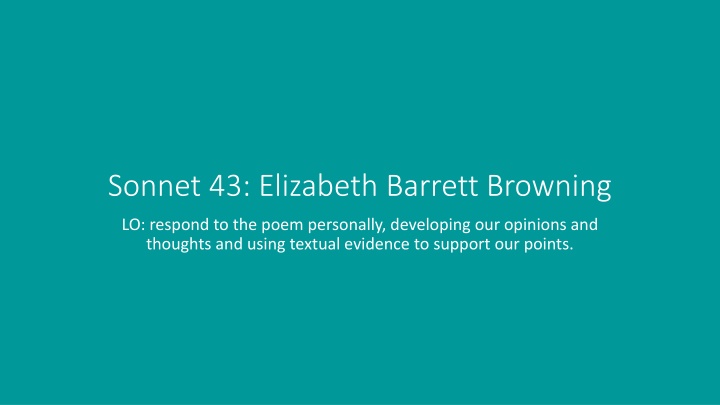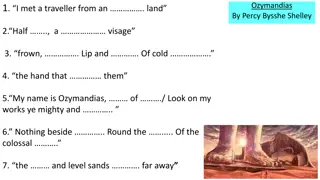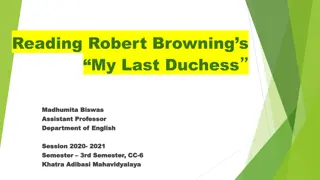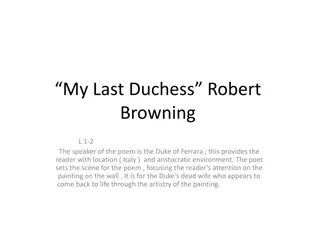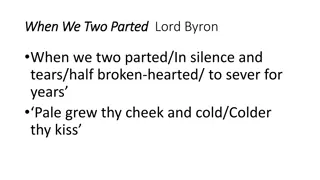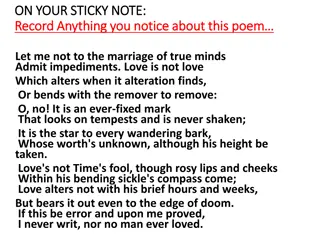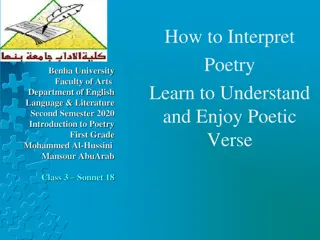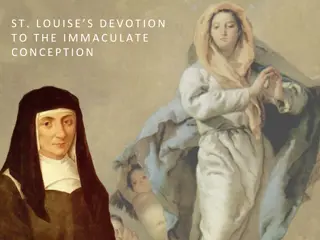Analysis of Love and Devotion in Sonnet 43 by Elizabeth Barrett Browning
Sonnet 43 by Elizabeth Barrett Browning portrays intense love and unwavering devotion as the speaker expresses a deep connection with her lover, describing their love as spiritual and boundless. Through analysis of language, structure, and form, the poem reveals the speaker's profound emotions, the use of hyperbole to emphasize her feelings, religious language to signify the significance of love in her life, and repetition to convey the depth of her affection.
Download Presentation

Please find below an Image/Link to download the presentation.
The content on the website is provided AS IS for your information and personal use only. It may not be sold, licensed, or shared on other websites without obtaining consent from the author.If you encounter any issues during the download, it is possible that the publisher has removed the file from their server.
You are allowed to download the files provided on this website for personal or commercial use, subject to the condition that they are used lawfully. All files are the property of their respective owners.
The content on the website is provided AS IS for your information and personal use only. It may not be sold, licensed, or shared on other websites without obtaining consent from the author.
E N D
Presentation Transcript
Sonnet 43: Elizabeth Barrett Browning LO: respond to the poem personally, developing our opinions and thoughts and using textual evidence to support our points.
Sonnet 43: The speaker expresses her intense love for her lover, counting all the different ways in which she loves him. She loves him so deeply that she sees their love as spiritual and sacred. Her love is so great that she believes she will love him even after death.
Analysis: language, structure and form form Form: Barrett follows tradition by writing her love poem in the form of a Petrachan sonnet. It means it conforms to a specific rhyme scheme. It is written in iambic pentameter, and therefore mirrors the rhythm of normal speech, but the metre is disrupted by pauses and repetition making the speaker sound passionate. The use of first person also makes the poem sound and feel personal.
Analysis: language, structure structure and form The poem is made up of a series of different ways if defining the speaker s love. The octave (first 8 lines) introduces the poem s main theme- the idea that her love is so intense, it is almost divine. The sestet (remaining 6 lines) then develops the theme by showing she loves him with the emotions of an entire lifetime- from childhood through to, and past death.
Analysis: language language, structure and form Exaggerated language: the poem uses hyperbole to show the strength of the speaker s feelings. She uses exaggeration as she attempts to put feelings into words- she is keen to emphasise both the scale of her love and the fact that she experiences this love for her whole life.
Analysis: language language, structure and form Religious Language: the speaker s love is like a religion to her- it touches all aspects of her life and gives meaning to her existence. Her love is unconditional, like religious faith.
Analysis: language language, structure and form Repetition: using the same words on consecutive lines is called anaphora. It emphasises the strength of her feelings- it s as if words can t convey the intensity of her emotions, so she just has to keep repeating the same ones to express the depth of her love.
Themes: Deep and Lasting Love: the speaker uses descriptions of spiritual love to emphasise the strength of her feelings. The final line also implies that her love is everlasting. Unselfish Love: the speaker asks for nothing in return. She compares herself to people who try and do the right thing without expecting a reward. Virtue: she considers her love to be morally and spiritually right and worthy of God s support.
Context: Gaining notoriety for her work in the 1830s, Elizabeth continued to live in her father's London house under his tyrannical rule. He began sending Elizabeth's younger siblings to Jamaica to help with the family's estates. Elizabeth bitterly opposed slavery and did not want her siblings sent away. During this time, she wrote The Seraphim and Other Poems (1838), expressing Christian sentiments in the form of classical Greek tragedy. Due to her weakening disposition she was forced to spend a year at the sea of Torquay accompanied by her brother Edward, whom she referred to as "Bro." He drowned later that year while sailing at Torquay and Elizabeth returned home emotionally broken, becoming an invalid and a recluse. She spent the next five years in her bedroom at her father's home. She continued writing, however, and in 1844 produced a collection entitled simply Poems. This volume gained the attention of poet Robert Browning, whose work Elizabeth had praised in one of her poems, and he wrote her a letter.
Background - continued Elizabeth and Robert, who was six years her junior, exchanged 574 letters over the next twenty months. Their romance was bitterly opposed by her father, who did not want any of his children to marry. In 1846, the couple eloped and settled in Florence, Italy, where Elizabeth's health improved and she bore a son, Robert Wideman Browning. Her father never spoke to her again. Elizabeth's Sonnets from the Portuguese, dedicated to her husband and written in secret before her marriage, was published in 1850. Critics generally consider the Sonnets one of the most widely known collections of love lyrics in English to be her best work. Admirers have compared her imagery to Shakespeare and her use of the Italian form to Petrarch.
The poem counts each of these ways as it progresses. Makes the speaker sound methodical and intense. Question makes the poem s theme clear from the start. Sonnet 43: Addresses the object of her love as thee - its direct and personal. However, the lack of name and gender makes the poem seem universal. Shows the scale of her love. Repetition of and reflects her excitement and passion. How do I love thee? Let me count the ways!- I love thee to the depth and breadth and height My soul can reach, when feeling out of sight For the ends of Being and ideal Grace. Enjambment emphasises the speakers passion- it suggests she is overflowing with love. Capitals suggest these words are being used in a spiritual sense. The speaker s love is so deep it is like the desire to understand existence and get close to God. This would have resonated strongly with readers in the 19th Century as society was more religious then.
This is a different side to her love- it is calm, constant part of everyday life too. Sonnet 43: Anaphora shows the strength of her feelings. It also emphasises the different words that follow ( freely and purely ) which describe her love. She loves him as willingly as people who always try to do the right thing, and as purely as modest people who turn away from being praised. The link to virtuous conduct suggests her love is morally right. I love thee to the level of every day s Most quiet need, by sun and candle-light- I love thee freely, as men strive for Right,- I love thee purely, as they turn from Praise. The use of a word referring back to a word used earlier in a text or conversation, to avoid repetition, for example the pronouns he, she, it, and they and the verb do in I like it and so do they.
Mixture of positive and negative emotions shows that she loves him with everything she has- it all links back to her love for him. She loves him with a passion that religion gave her as a child. This could suggest that her lover has replaced her faith- she almost idolises him. Sonnet 43: I love thee with the passion, put to use In my old griefs, and with my childhood s faith: I love thee with a love I seemed to lose With my lost Saints,- I love thee with the breath,
Mixture of positive and negative emotions shows that she loves him with everything she has- it all links back to her love for him. Caesura breaks up the rhythm and makes her sound breathless with excitement. Sonnet 43: Smiles, tears, of all my life!- and, if God choose, I shall but love thee better after death. Their love is presented as eternal as it will outlive their time on earth. The speaker s hope that God supports their love suggests that she believes in its purity.
Your response: Must: why do you think the speaker hopes that her love is supported by God? Should: what is the effect of the rhyme of breath and death in lines 12 and 14? Could: the speaker focuses only on the positives of love in this poem. What is the effect of this?
AO1: Compare the ways love is presented in La Belle and Sonnet 43. Think about: The characteristics of love The representation of the people involved The feelings of the speaker Any imagery or language used The way the structure and form reflects this Write a detailed plan of your answer. Make sure you include and analyse quotations from the text.
